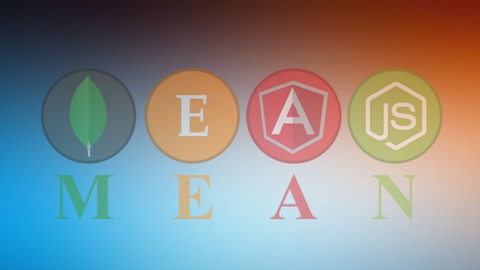
MEAN Stack Angular Material Node.js Angular App [2022]
MEAN Stack Angular Material Node.js Angular App [2022], available at $84.99, has an average rating of 4.2, with 64 lectures, based on 13 reviews, and has 80 subscribers.
You will learn about Create an Web Application of type eCommerce Using the MEAN Stack and Angular Material Choose between Backend or Frontend development or do Both (Fullstack) thanks to the course resources that wiil be available Learn Backend development with Node js Learn Mongoose Commands and Queries to be able to communicate with your Database Learn to Implement Authentication based on JWT Learn how to encrypt passwords using Bcrypt Learn File Upload of images using Multer Animate your components to make them move on your page Learn how to integrate Angular Material components to your API This course is ideal for individuals who are This is a MEAN Stack course or . But what does MEAN Actually stand for ? It is an acronym that means : MongoDB, Express, Angular and Node js. or So to sum up, a MEAN Stack is a free and openSource software coded in Javascript with its framework : Angular. We will be or In this course you will learn how to implement : or Angular material components or Password encryption to protect the users of your App or Jwt-Tokens or File uploads (images) or Filtering data using Angular Pipes or Creating http request to the server or Animating images in your components or And much more… or You will learn how to configure a development environment. By the time you complete this course you will have assimilated all there is to know about backend programming with Node js and about frontend development with Angular. You will also have learnt how to communicate with your database using mongoose commands. It is particularly useful for This is a MEAN Stack course or . But what does MEAN Actually stand for ? It is an acronym that means : MongoDB, Express, Angular and Node js. or So to sum up, a MEAN Stack is a free and openSource software coded in Javascript with its framework : Angular. We will be or In this course you will learn how to implement : or Angular material components or Password encryption to protect the users of your App or Jwt-Tokens or File uploads (images) or Filtering data using Angular Pipes or Creating http request to the server or Animating images in your components or And much more… or You will learn how to configure a development environment. By the time you complete this course you will have assimilated all there is to know about backend programming with Node js and about frontend development with Angular. You will also have learnt how to communicate with your database using mongoose commands.
Enroll now: MEAN Stack Angular Material Node.js Angular App [2022]
Summary
Title: MEAN Stack Angular Material Node.js Angular App [2022]
Price: $84.99
Average Rating: 4.2
Number of Lectures: 64
Number of Published Lectures: 64
Number of Curriculum Items: 64
Number of Published Curriculum Objects: 64
Original Price: $22.99
Quality Status: approved
Status: Live
What You Will Learn
- Create an Web Application of type eCommerce Using the MEAN Stack and Angular Material
- Choose between Backend or Frontend development or do Both (Fullstack) thanks to the course resources that wiil be available
- Learn Backend development with Node js
- Learn Mongoose Commands and Queries to be able to communicate with your Database
- Learn to Implement Authentication based on JWT
- Learn how to encrypt passwords using Bcrypt
- Learn File Upload of images using Multer
- Animate your components to make them move on your page
- Learn how to integrate Angular Material components to your API
Who Should Attend
- This is a MEAN Stack course
- . But what does MEAN Actually stand for ? It is an acronym that means : MongoDB, Express, Angular and Node js.
- So to sum up, a MEAN Stack is a free and openSource software coded in Javascript with its framework : Angular. We will be
- In this course you will learn how to implement :
- Angular material components
- Password encryption to protect the users of your App
- Jwt-Tokens
- File uploads (images)
- Filtering data using Angular Pipes
- Creating http request to the server
- Animating images in your components
- And much more…
- You will learn how to configure a development environment. By the time you complete this course you will have assimilated all there is to know about backend programming with Node js and about frontend development with Angular. You will also have learnt how to communicate with your database using mongoose commands.
Target Audiences
- This is a MEAN Stack course
- . But what does MEAN Actually stand for ? It is an acronym that means : MongoDB, Express, Angular and Node js.
- So to sum up, a MEAN Stack is a free and openSource software coded in Javascript with its framework : Angular. We will be
- In this course you will learn how to implement :
- Angular material components
- Password encryption to protect the users of your App
- Jwt-Tokens
- File uploads (images)
- Filtering data using Angular Pipes
- Creating http request to the server
- Animating images in your components
- And much more…
- You will learn how to configure a development environment. By the time you complete this course you will have assimilated all there is to know about backend programming with Node js and about frontend development with Angular. You will also have learnt how to communicate with your database using mongoose commands.
Build a fullsatck MEAN e-commerce Application. But what is a MEAN Stack ?
Well MEAN stands for : MongoDB, Express, Angular and Node js. To sum up, the MEAN stack is a connected software that we will create coded in Javascript and more precisely with Angular as a frontend framework and Node js as a backend framework.
You will learn about file upload, angular pipes for filtering data, integrating angular material components to your api, communicating with a database through mongoose, and much more ! This course covers in detail every aspect of creating a backend with Node js. It also teaches you how to test your routes by using a mock api software named Postman. Further more, you are to discover everything there is to know about a frontend coded with Angular.
About the UI Library you will be using in this course : Angular material is a library created by google in 2014 and still in use with many updates until today. I had the opportunity to use it in my professional career. It contains all sorts of components from loading spinners, to modal or pop-ups, even snackbars. This course targets developers from different levels, from beginners to advanced.
You are expected to know the very basic terms of Javascript, Angular and Node js such as “Services”, “Components”, “npm packages”. But if you are not familiar with these terms you can learn them on the go.
Course Curriculum
Chapter 1: Introduction
Lecture 1: Introduction
Lecture 2: Who is this course meant for and What is Angular Material ?
Lecture 3: Softwares needed
Chapter 2: Backend : Getting started
Lecture 1: Our first route
Lecture 2: Environment Variables
Lecture 3: Morgan and introduction to Postman
Lecture 4: npm Packages
Lecture 5: Connection to MongoDB Atlas
Lecture 6: Model Creation
Lecture 7: app.js refactoring
Lecture 8: CORS policy management
Chapter 3: Backend : Models and Categories
Lecture 1: Models creation
Lecture 2: Categories methods (part 1)
Lecture 3: Category methods (part 2)
Chapter 4: Backend : Image upload and Items management
Lecture 1: Image Upload and Items management
Lecture 2: Items PUT method
Lecture 3: Items delete method
Chapter 5: Backend : Users and Cart
Lecture 1: User GET routes
Lecture 2: Password encryption and POST method for users
Lecture 3: Users PUT method
Lecture 4: Login route and token creation
Lecture 5: JWT-Token block (securing our backend)
Lecture 6: Creating a new Cart (POST method)
Lecture 7: Carts management
Lecture 8: A few more features before moving on
Lecture 9: Resources of the Backend
Chapter 6: Frontend : Project creation and Categories
Lecture 1: Project creation and first components
Lecture 2: Category Model and Service
Lecture 3: Category List (part 1)
Lecture 4: Category List (part 2)
Lecture 5: Category Form (part 1)
Lecture 6: Category Form (part 2)
Chapter 7: Frontend : Items
Lecture 1: Items model and Service
Lecture 2: Displaying items in the shop
Lecture 3: Dropdown Category Filter
Lecture 4: Search Bar creation using Pipe
Lecture 5: Item List Table
Lecture 6: Item deletion
Lecture 7: Items form
Lecture 8: Items form (editing and creating items)
Lecture 9: Details of a single item
Lecture 10: Creating an animation
Chapter 8: Frontend : Users
Lecture 1: User model and service
Lecture 2: Quick correction video
Lecture 3: Token localStorage
Lecture 4: Login Form
Lecture 5: Creating animations
Lecture 6: Login with Jwt Token
Lecture 7: Signing up to the app as a non-admin user
Lecture 8: Interceptor Configuration
Lecture 9: Guard Service
Lecture 10: User Service
Lecture 11: User List Management
Lecture 12: User Deletion
Lecture 13: User Form (part 1)
Lecture 14: User Form (part 2)
Chapter 9: Frontend : Cart
Lecture 1: Cart Model and Service
Lecture 2: Adding Items to Cart
Lecture 3: Creating our Cart Component (part 1)
Lecture 4: Creating our Cart (part 2)
Chapter 10: Authorization
Lecture 1: Customizing the Header
Lecture 2: Quick changes
Chapter 11: App Deployment
Lecture 1: Backend Deployment
Lecture 2: Frontend Deployment
Instructors
-
Youssef Kharoufi
Développeur Full Stack
Rating Distribution
- 1 stars: 0 votes
- 2 stars: 0 votes
- 3 stars: 2 votes
- 4 stars: 6 votes
- 5 stars: 5 votes
Frequently Asked Questions
How long do I have access to the course materials?
You can view and review the lecture materials indefinitely, like an on-demand channel.
Can I take my courses with me wherever I go?
Definitely! If you have an internet connection, courses on Udemy are available on any device at any time. If you don’t have an internet connection, some instructors also let their students download course lectures. That’s up to the instructor though, so make sure you get on their good side!
You may also like
- Best Video Editing Courses to Learn in March 2025
- Best Music Production Courses to Learn in March 2025
- Best Animation Courses to Learn in March 2025
- Best Digital Illustration Courses to Learn in March 2025
- Best Renewable Energy Courses to Learn in March 2025
- Best Sustainable Living Courses to Learn in March 2025
- Best Ethical AI Courses to Learn in March 2025
- Best Cybersecurity Fundamentals Courses to Learn in March 2025
- Best Smart Home Technology Courses to Learn in March 2025
- Best Holistic Health Courses to Learn in March 2025
- Best Nutrition And Diet Planning Courses to Learn in March 2025
- Best Yoga Instruction Courses to Learn in March 2025
- Best Stress Management Courses to Learn in March 2025
- Best Mindfulness Meditation Courses to Learn in March 2025
- Best Life Coaching Courses to Learn in March 2025
- Best Career Development Courses to Learn in March 2025
- Best Relationship Building Courses to Learn in March 2025
- Best Parenting Skills Courses to Learn in March 2025
- Best Home Improvement Courses to Learn in March 2025
- Best Gardening Courses to Learn in March 2025






















